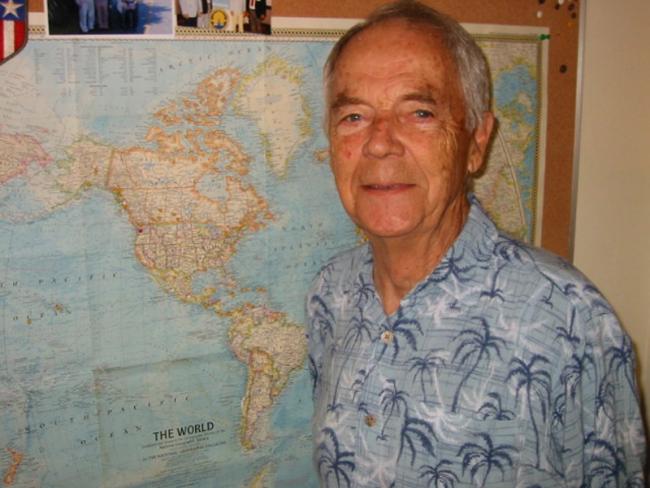Des Moines veteran, world traveler charms seagulls
Veteran traveler Tom Warp stands in front of a map of the world.
Tue, 08/24/2010
I imagine that Tom Warp might be referred to as 'that seagull guy' around the Des Moines Marina, as he has an uncanny way with seagulls.
He said, "I walk two miles every morning along the marina. The seagulls recognize me and fly over to meet me. They'll just drool as they wait for some nutritious bread, and Gentle Ben eats right out of my hand".
Perhaps it's because of his early association with feathered creatures, during his childhood on an old chicken farm in the suburbs of Tacoma.
"We had chickens, cows, goats and hours of fun playin' with the pigs. They were so clean that we could roll around in the barn with them. They'd always pick a corner to do their bathroom duties and the rest was nice and clean," Tom said with a bright smile.
Tom has plenty of heritage, but is Norwegian through and through! His father came from Norway when he was only 16 and settled where it looked the most like his homeland - the West Coast.
Tom was born in 1925, and his father worked for the railroad. His office was down on Commencement Bay. "As kids, we'd just roam on down to Dad's office or wherever we wanted to go. We didn't have any of the concerns that kids do today," Tom said.
As is typical with the farm life, animals were both friend and food. He talked of his pet, a black and white goat. "One day, my folks would just say, 'it was time to eat it' and they'd cook the goat, skin him and I'd have a black and white rug on my floor."
However, Tom's sites were set for adventure. He always knew that he wanted to be in the Navy. He got the enlistment papers weeks before he even graduated high school and had them ready for his parent to sign, as he was still only 17.
He was given three choices: submarine, destroyer or aviation. "I chose to fly, because I've always liked site-seeing and figured I could see the most from a plane." Tom served as a PB4-2 nose-gunner from 1943 to 1947, for which he received an Air Medal and several other honors.
After he drew the configuration of the plane, I had to ask him how he got out of there, if they got hit. He said, "I had to accept the fact that I wasn't going to live." He said that one third of the US planes were shot down.
Despite the risky nature of his job, he found himself depressed at the end of the war. Coming back to their base station in Okinawa, he said that it was like going to a wake. No celebration - no hilarity.
"After the war, what does a gunner do?" he mused. So he went the UW and ended up at Boeing as a design engineer. In 1982, he retired after 32 years at the Big B.
Looking back to his time in the Navy, he said, "Combat is a fascinating thing. You get absorbed in it. It's thrilling. The camaraderie and the dangers were irreplaceable, but I wouldn't want to do it again." Then he added, "but I'd be tempted." Tom went on to serve in the Naval Reserves and was discharged in1952.
Travel has been a huge part of his life, and he and his wife Jeanne have traveled to so many places that it would be much easier for me to write where they haven't been. An interesting note is that Tom wrote a book about his combat adventures called "From High School to Hiroshima." Kim Warp, his daughter, is a lead cartoonist for The New Yorker.
In 1989, Tom and Jeanne returned to Okinawa. He walked out onto the airfield that he flew from, back when he was a young pup. He said, "When I came back to the taxi cab, I just cried and cried and cried."
I wonder that our memories won't always be the most precious things in our future. And there's something about the life and death events, in our lives, that create a bond to one another that is, as Tom puts it, "irreplaceable."


